The Impact of Process Heat on the Decarbonisation Potential of Offshore Installations by Hybrid Energy Systems
Abstract
1. Introduction
2. Power and Heat Demand in Oil & Gas Extraction
3. Hybrid Energy System for Offshore Installations
- Wind is the primary source of power. The fuel cell stack is the first backup power source, while the GT covers the remaining gaps in power production.
- Surplus wind power is converted to hydrogen rather than dissipated unless system constraints make it unfeasible (e.g., to constrain the size of hydrogen storage).
- Hydrogen produced is primarily used in the fuel cell. Whenever the maximum capacity of the fuel cell stack is reached, the hydrogen surplus is fed to the GT.
4. Methods to Supply Process Heat
4.1. Internal Heat Recovery
4.2. Waste Heat Recovery from Flue Gases
4.3. Power to Heat
4.4. Gas-Fired Heater
5. Generic Offshore Installation
- Power demand: 30 MW;
- Heat demand: 8 MW.
- Gas turbine model: LM2500 + G4;
- Max. content of H2 in GT fuel: 22 %vol.;
- Fuel cell stack capacity: 5 MW;
- Electrolyser stack capacity: 10 MW;
- H2 storage capacity: 5000 kg;
- Wind farm power capacity: 10–50 MW.
6. Results
6.1. Influence of Heat Generation in the Base Case Scenario
6.2. Different Heat to Power Ratios
- (a)
- Heat = 8 MW; Power = 20 MW; H/P = 0.40
- (b)
- Heat = 8 MW; Power = 25 MW; H/P = 0.32
- (c)
- Heat = 8 MW; Power = 35 MW; H/P = 0.23
- (d)
- Heat = 8 MW; Power = 40 MW; H/P = 0.20
6.3. The Role of the Fuel Cell Stack
7. Summary and Conclusions
Author Contributions
Funding
Conflicts of Interest
References
- IPCC. Special Report: Global Warming of 1.5 °C; Cambridge University Press: Cambridge, UK, 2021. [Google Scholar]
- Statistisk Sentralbyrå Emissions to Air. Available online: https://www.ssb.no/en/natur-og-miljo/forurensning-og-klima/statistikk/utslipp-til-luft (accessed on 15 October 2021).
- NDC Registry—Norway. Available online: https://www4.unfccc.int/sites/NDCStaging/pages/Party.aspx?party=NOR (accessed on 15 October 2021).
- KonKraft. The Energy Industry Of Tomorrow On The Norwegian Continental Shelf. 2020. Available online: https://konkraft.no/wp-content/uploads/2021/04/The-energy-industry-of-tomorrow-on-the-NCS-KonKraft-report-2021-2-FINAL.pdf (accessed on 15 October 2021).
- Riboldi, L.; Nord, L.O. Concepts for lifetime efficient supply of power and heat to offshore installations in the North Sea. Energy Convers. Manag. 2017, 148, 860–875. [Google Scholar] [CrossRef]
- Pierobon, L.; Kandepu, R.; Haglind, F. Waste Heat Recovery for Offshore Applications. In Proceedings of the ASME 2012 International Mechanical Engineering Congress and Exposition, MECE2012, Houston, TX, USA, 9–15 November 2012; pp. 1–10. [Google Scholar]
- Van Nguyen, T.; Barbosa, Y.M.; da Silva, J.A.M.; de Oliveira Junior, S. A novel methodology for the design and optimisation of oil and gas offshore platforms. Energy 2019, 185, 158–175. [Google Scholar] [CrossRef]
- Riboldi, L.; Nord, L.O. Lifetime assessment of combined cycles for cogeneration of power and heat in offshore oil and gas installations. Energies 2017, 10, 744. [Google Scholar] [CrossRef]
- Mazzetti, J.M.; Nekså, P.; Walnum, H.T.; Hemmingsen, A.K.T. Energy-Efficient Technologies for Reduction of Offshore CO2 Emmissions. In Proceedings of the Offshore Technology Conference, Houston, TX, USA, 6–9 May 2013. [Google Scholar]
- Korpås, M.; Warland, L.; He, W.; Tande, J.O.G. A case-study on offshore wind power supply to oil and gas rigs. Energy Procedia 2012, 24, 18–26. [Google Scholar] [CrossRef]
- Riboldi, L.; Nord, L.O. Offshore Power Plants Integrating a Wind Farm: Design Optimisation and Techno-Economic Assessment Based on Surrogate Modelling. Processes 2018, 6, 249. [Google Scholar] [CrossRef]
- Oliveira-Pinto, S.; Rosa-Santos, P.; Taveira-Pinto, F. Assessment of the potential of combining wave and solar energy resources to power supply worldwide offshore oil and gas platforms. Energy Convers. Manag. 2020, 223, 113299. [Google Scholar] [CrossRef]
- He, W.; Jacobsen, G.; Anderson, T.; Olsen, F.; Hanson, T.; Korpås, M.; Toftevaag, T.; Eek, J.; Uhlen, K.; Johansson, E. The potential of integrating wind power with offshore oil and gas platforms. Wind Eng. 2010, 34, 125–137. [Google Scholar] [CrossRef]
- Riboldi, L.; Völler, S.; Korpås, M.; Nord, L.O. An Integrated Assessment of the Environmental and Economic Impact of Offshore Oil Platform Electrification. Energies 2019, 12, 2114. [Google Scholar] [CrossRef]
- Roussanaly, S.; Aasen, A.; Anatharaman, R.; Danielsen, B.; Jakobsen, J.; Heme-De-Lacotte, L.; Neji, G.; Sødal, A.; Wahl, P.E.; Vrana, T.K.; et al. Offshore power generation with CCS to decarbonise mainland electricity and offshore oil and gas installations: A techno-economic analysis. Appl. Energy 2018, in press. [Google Scholar]
- Riboldi, L.; Alves, E.F.; Pilarczyk, M.; Tedeschi, E.; Nord, L.O. Innovative Hybrid Energy System for stable Power and Heat Supply in offshore oil & gas Installation (HES-OFF): System Design and Grid Stability; Elsevier: Amsterdam, The Netherlands, 2020; Volume 48. [Google Scholar]
- Riboldi, L.; Alves, E.F.; Pilarczyk, M.; Tedeschi, E.; Nord, L.O. Optimal Design of a Hybrid Energy System for the Supply of Clean and Stable Energy to Offshore Installations. Front. Energy Res. 2020, 8, 346. [Google Scholar] [CrossRef]
- Nami, H.; Ertesvåg, I.S.; Agromayor, R.; Riboldi, L.; Nord, L.O. Gas turbine exhaust gas heat recovery by organic Rankine cycles (ORC) for offshore combined heat and power applications-Energy and exergy analysis. Energy 2018, 165, 1060–1071. [Google Scholar] [CrossRef]
- Barbosa, Y.M.; da Silva, J.A.M.; Junior, S.d.O.; Torres, E.A. Performance assessment of primary petroleum production cogeneration plants. Energy 2018, 160, 233–244. [Google Scholar] [CrossRef]
- Van Nguyen, T.; Fülop, T.G.; Breuhaus, P.; Elmegaard, B. Life performance of oil and gas platforms: Site integration and thermodynamic evaluation. Energy 2014, 73, 282–301. [Google Scholar] [CrossRef]
- Van Nguyen, T.; Jacyno, T.; Breuhaus, P.; Voldsund, M.; Elmegaard, B. Thermodynamic analysis of an upstream petroleum plant operated on a mature field. Energy 2014, 68, 454–469. [Google Scholar] [CrossRef]
- Chauhan, A.; Saini, R.P. A review on Integrated Renewable Energy System based power generation for stand-alone applications: Configurations, storage options, sizing methodologies and control. Renew. Sustain. Energy Rev. 2014, 38, 99–120. [Google Scholar] [CrossRef]
- Goldmeer, J. Fuel Flexible Gas Turbines as Enablers for a Low or Reduced Carbon Energy Ecosystem; Electrify Europe: Vienna, Austria, 2018. [Google Scholar]
- Thermoflow Inc. Thermoflex Version 29.0 2021; Thermoflow Inc.: Jacksonville, FL, USA, 2021. [Google Scholar]
- The MathWorks Inc. MATLAB R2020a 2020; The MathWorks Inc.: Natick, MA, USA, 2020. [Google Scholar]
- Gelaro, R.; McCarty, W.; Suárez, M.J.; Todling, R.; Molod, A.; Takacs, L.; Randles, C.A.; Darmenov, A.; Bosilovich, M.G.; Reichle, R.; et al. The Modern-Era Retrospective Analysis for Research and Applications, Version 2 (MERRA-2). J. Clim. 2021, 30, 5419–5454. [Google Scholar] [CrossRef] [PubMed]
- Ramadam, A. Energy Optimization of Offshore Gas Field; Norwegian University of Science and Technology: Trondheim, Norway, 2021. [Google Scholar]
- Lowe, C.; Brancaccio, N.; Batten, D.; Leung, C.; Waibel, D. Energy Procedia Technology Assessment of Hydrogen Firing of Process Heaters. Energy Procedia 2011, 4, 1058–1065. [Google Scholar] [CrossRef][Green Version]
- Alves, E.; Sanchez, S.; Brandao, D.; Tedeschi, E. Smart load management with energy storage for power quality enhancement in wind-powered oil and gas applications. Energies 2019, 14, 2985. [Google Scholar] [CrossRef]
- Barbir, F. PEM Fuel Cells—Theory and Practice; Academic Press: Amsterdam, The Netherlands, 2005. [Google Scholar]
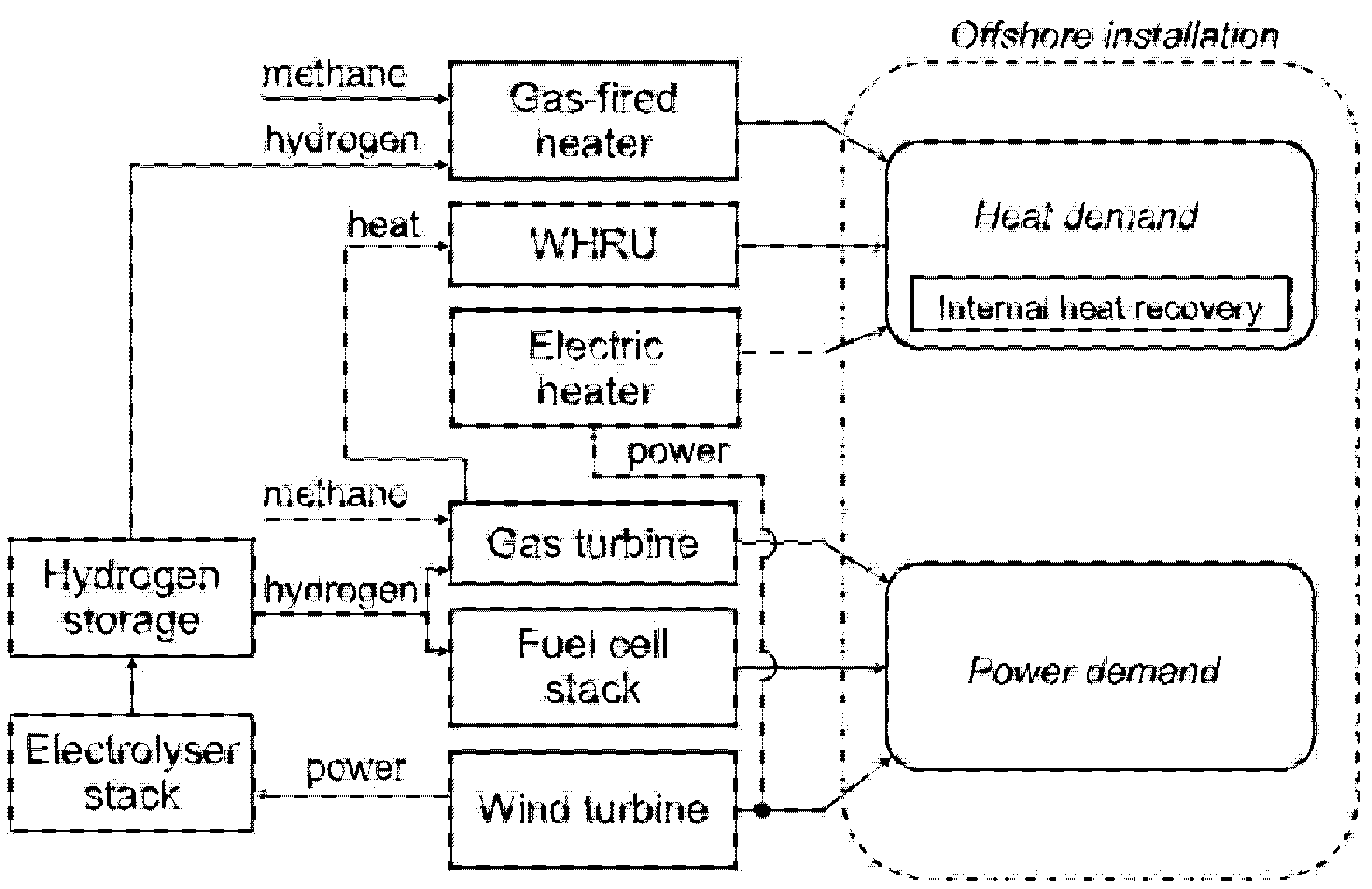

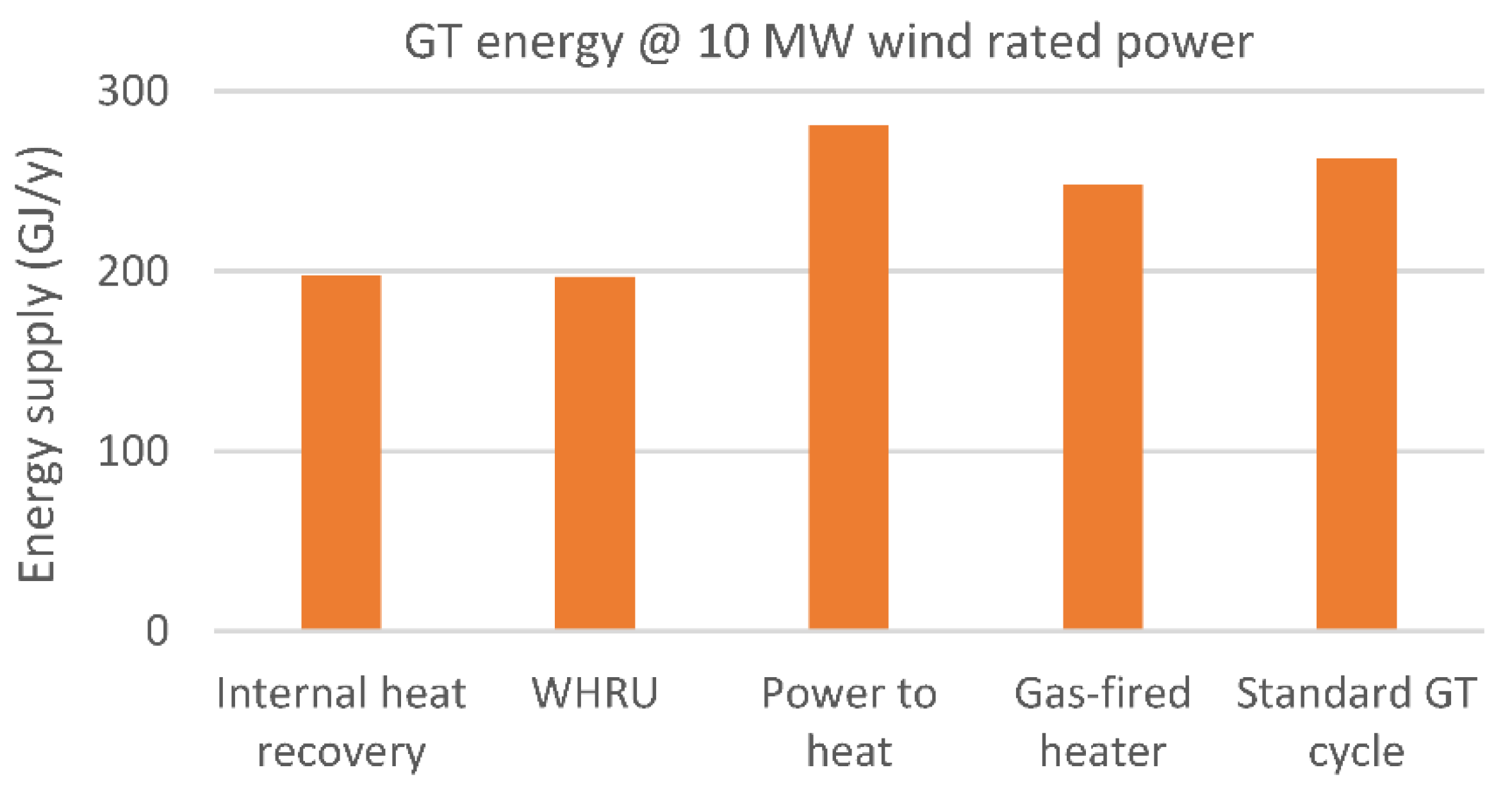
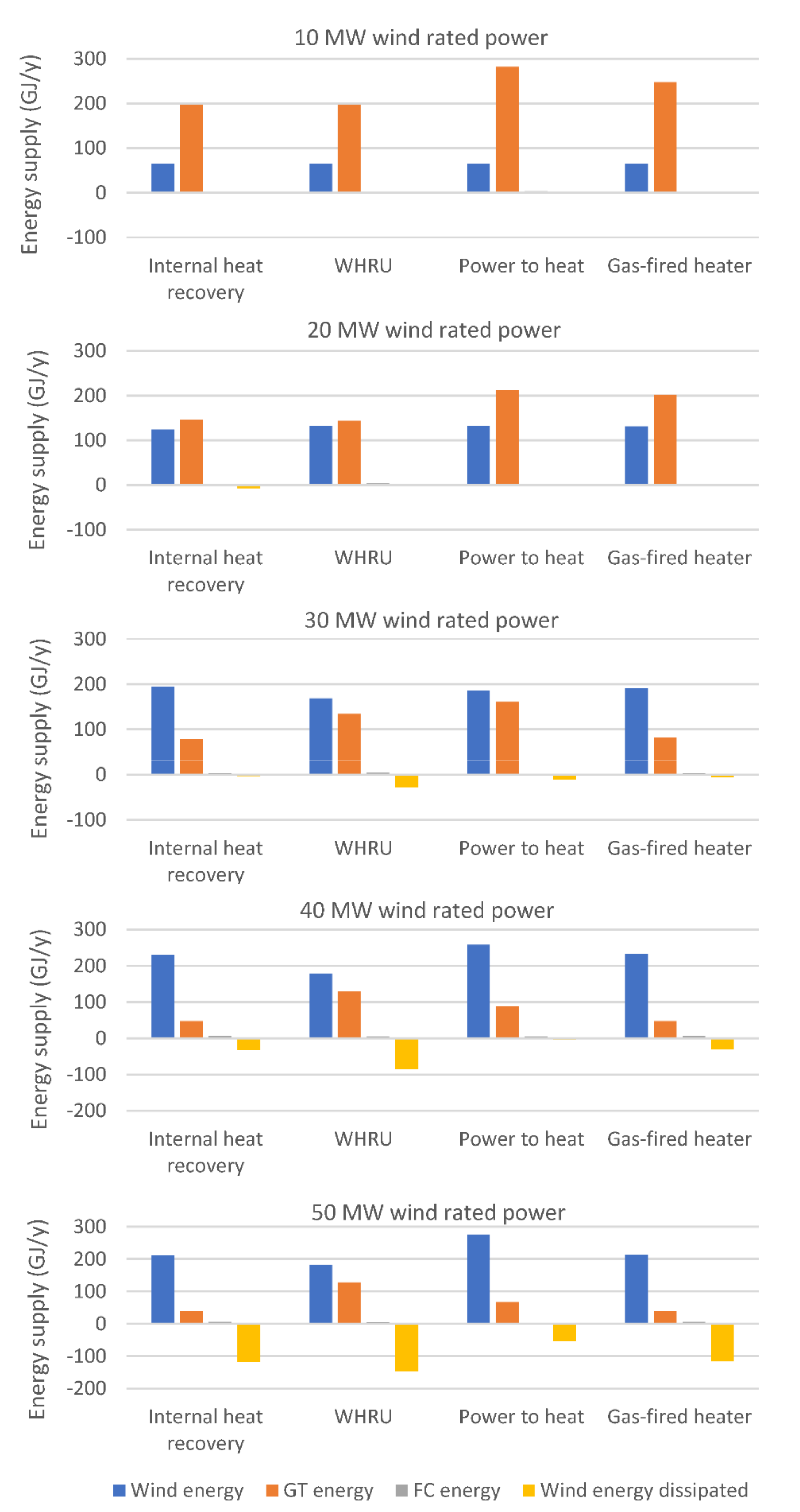
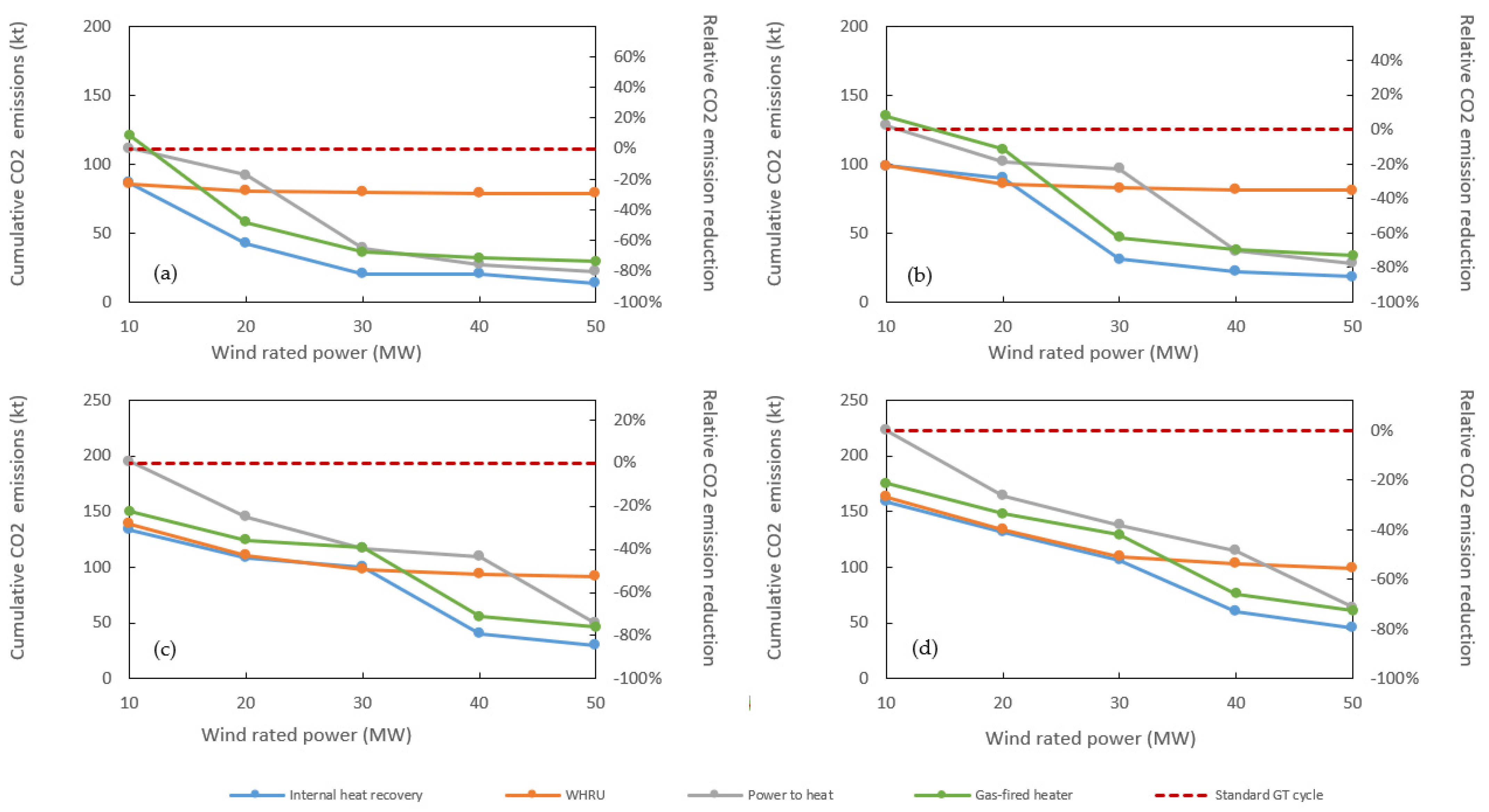

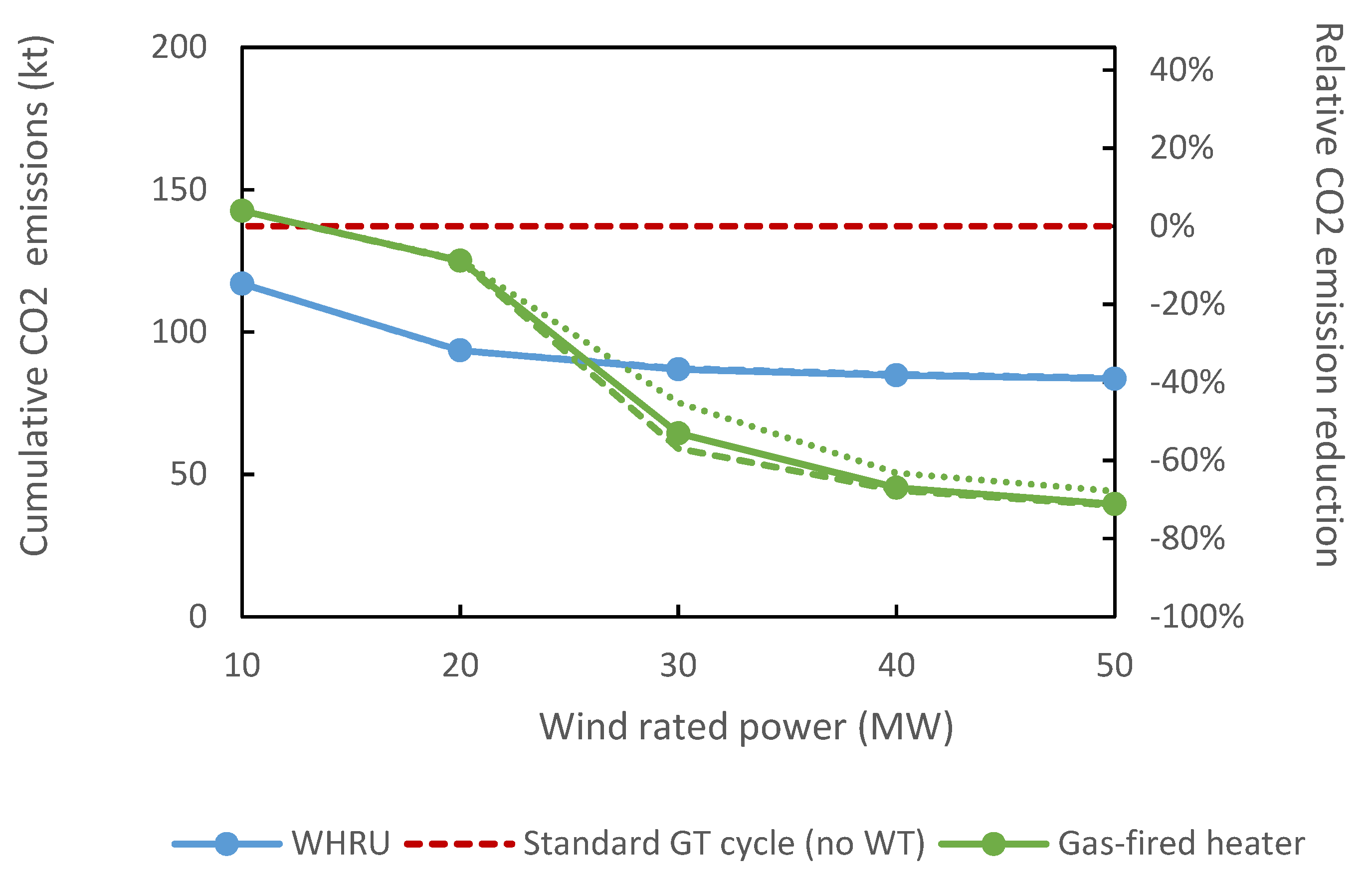
Publisher’s Note: MDPI stays neutral with regard to jurisdictional claims in published maps and institutional affiliations. |
© 2021 by the authors. Licensee MDPI, Basel, Switzerland. This article is an open access article distributed under the terms and conditions of the Creative Commons Attribution (CC BY) license (https://creativecommons.org/licenses/by/4.0/).
Share and Cite
Riboldi, L.; Pilarczyk, M.; Nord, L.O. The Impact of Process Heat on the Decarbonisation Potential of Offshore Installations by Hybrid Energy Systems. Energies 2021, 14, 8123. https://doi.org/10.3390/en14238123
Riboldi L, Pilarczyk M, Nord LO. The Impact of Process Heat on the Decarbonisation Potential of Offshore Installations by Hybrid Energy Systems. Energies. 2021; 14(23):8123. https://doi.org/10.3390/en14238123
Chicago/Turabian StyleRiboldi, Luca, Marcin Pilarczyk, and Lars O. Nord. 2021. "The Impact of Process Heat on the Decarbonisation Potential of Offshore Installations by Hybrid Energy Systems" Energies 14, no. 23: 8123. https://doi.org/10.3390/en14238123
APA StyleRiboldi, L., Pilarczyk, M., & Nord, L. O. (2021). The Impact of Process Heat on the Decarbonisation Potential of Offshore Installations by Hybrid Energy Systems. Energies, 14(23), 8123. https://doi.org/10.3390/en14238123







